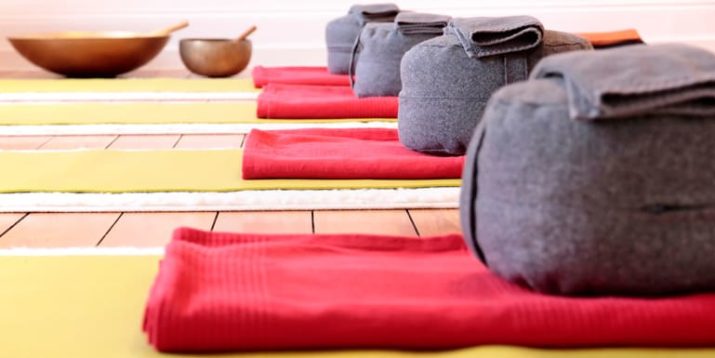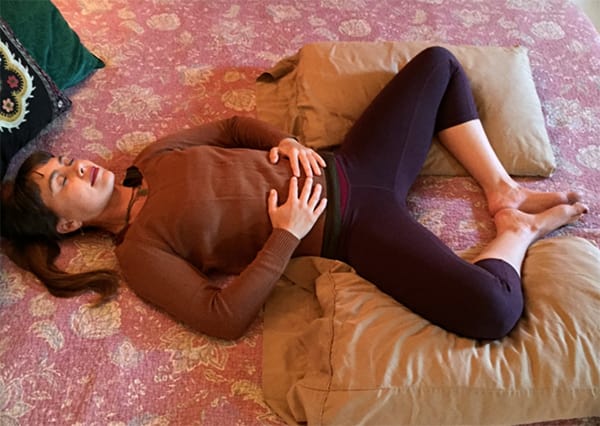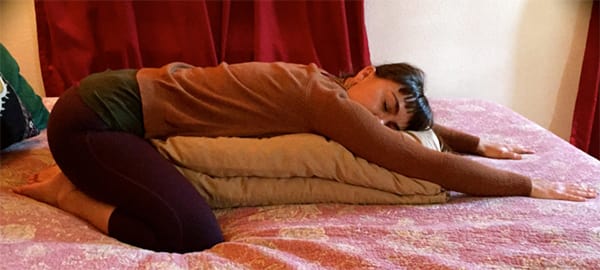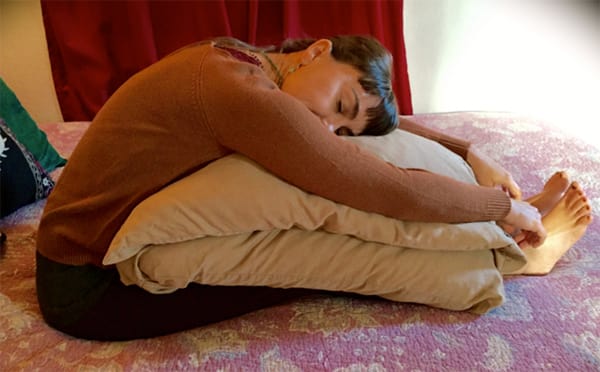What Is Yin Yoga?

Ours is an increasingly chaotic world in which we’re being bombarded by stimuli from all directions, requiring constant processing that can lead to chronic stress.
Fortunately, yin yoga can counter the chaos by offering some much-needed stillness.
What Is Yin Yoga?
Yin yoga is a slow-paced practice focusing on poses that stretch the hips, thighs, and lower back.
In a yin yoga sequence, poses are held for five minutes or more, typically with the support of blankets, blocks, straps, and bolsters.
At the foundation of yin yoga is the Taoist concept of yin and yang: opposite and complementary principles such as cold and hot.
Using the yin-yang symbol as a representation, yin symbolizes the dark, calm, and stable aspects of nature, while yang embodies its light, energetic, and dynamic aspects.
Accordingly, yin yoga poses stretch the subtle, more stable connective tissues of the body rather than the large, dynamic muscle groups that are worked in fast-paced yoga classes, such as vinyasa flow or ashtanga, which could be considered “yang” yoga.
Just as the symbol has equal parts yin and yang, incorporating some yin yoga into your high-energy workout schedule could provide vital balance.
3 Yin Yoga Benefits
1. It can help reduce stress
A yin yoga class offers you a rare chance to relax. Yin teachers will ask students to focus their attention inward, such as on the sound of their breath or the sensation of a stretch.
This focus on the body and the present moment can help to calm the mind. In a five-week study during which subjects practiced breathing techniques and yin poses, researchers found that each of the subjects reported an increase in body awareness and a decrease in stress levels.
2. It can improve flexibility
With some consistency, any yoga practice can increase your flexibility. However, yin yoga can take your flexibility to the next level.
By holding each pose, you’re giving the body a chance to stretch not only the muscles, but also the connective tissue that holds everything together, such as ligaments, tendons, and fascia (that’s the Saran Wrap-like sheath enveloping muscles throughout the body).
According to leading yin yoga teacher Paul Grilley, connective tissues need slow, steady pressure in order to relax, and this practice facilitates that.
Long, still poses gradually relieve the connective tissue of tension, enabling you to move more freely and engendering a greater range of motion.
3. It Can Help Lower Blood Pressure
Slowing down your pace can help relieve stress, and may also help lower your blood pressure.
One study showed that sitting still while taking deep breaths lowered blood pressure among highly stressed test subjects.
Yin yoga classes provide the time and place for you to just relax and breathe.
What to Know Before Doing a Yin Yoga Sequence
- Hold poses for as long as suggested if you can. Use your breath to calm you through the poses, and be sure to use props to make the poses more comfortable.
- Take your time getting to the deepest part of the stretch. You’ll be holding the pose for about five minutes or more, so there’s plenty of time to go deep.
- Try to keep your body as still as possible. Once you find the proper position, take a deep inhale and exhale, then stay there.
3 Yin Yoga Poses You Can Try at Home
Use any or all of these poses to create your own yin yoga sequence.
Supported butterfly pose (Supta baddha konasana)
This yin yoga pose can help decrease tension in the groin, hips and inner thighs.

- Lie on your back with your hands on your belly.
- Bend your knees and open them, allowing each to drop to its respective side, joining the soles of your feet together. Prop pillows under each knee in order to fully relax into the pose.
- Allow your head and shoulders to relax on the floor as you take 10 to 20 deep breaths.
Supported child’s pose (Balasana)
Try this yin yoga pose to release tension in the low back, hips, and inner thighs.

- Kneel on the floor with your toes together and knees splayed apart about 45 degrees.
- Stack two large pillows or fold a blanket in front of you, walk your hands forward and lay face-down onto the pillow/blanket with your head to one side. If this feels too tight in your hips, add another pillow or blanket to elevate your torso.
- Place your palms on the floor in front of you, and take 10 to 20 deep breaths.
- Turn your head to other side and repeat.
Supported forward fold (Pachimottanasana)

- Sit on the floor with your legs extended straight out in front of you.
- Lay two large pillows or a folded blanket on top of your legs and fold your torso and arms forward. If this feels too tight in your hips or low back, add another pillow or blanket to elevate your torso.
- Flex your ankles, turn your head to one side, relax your torso completely, and take 10 to 20 deep breaths.
- Turn your head to other side and repeat.
If you’re new to yoga, Beachbody’s 3 Week Yoga Retreat and Yoga52 are perfect ways for you to learn the foundations of the practice.
